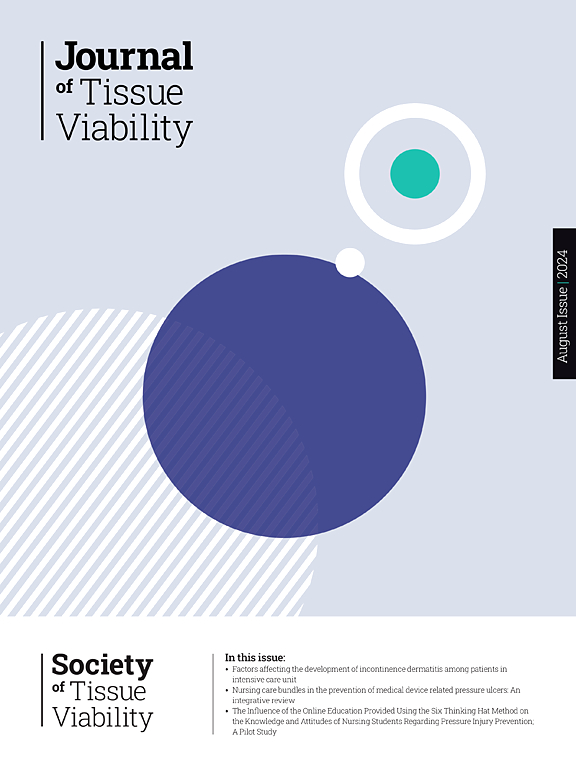降低培养箱湿度对外科创面早产儿皮肤改善的评价。
IF 2.4
3区 医学
Q2 DERMATOLOGY
引用次数: 0
摘要
背景:由于早产儿皮肤脆弱,术后切口感染的风险较高。培养箱湿度过高会影响早产儿术后伤口愈合。探讨降低培养箱内环境湿度对早产儿术后创面愈合的影响,为早产儿提供更科学有效的护理策略。方法:选取2023年1月~ 2024年3月在厦门市儿童医院SICU接受腹部手术的早产儿为研究对象。根据计算机生成的随机数,将所有患者随机分为实验组和对照组。培养箱的湿度根据对照组婴儿的胎龄和体重设定,实验组在此基础上降低10%。比较两组患者术前、术后24 h、7 d培养箱橡胶圈、门把手、床垫表面菌落数量。比较术前第1天、术后第3天、第8天NSCS评分、鼻尖、颈部、脐区、肛周区菌落数、皮肤感染、皮肤愈合情况。比较两组患者术后第1、2周体重及术后第1、3、7天尿量。结果:实验组与对照组术后第8天NSCS差异有统计学意义(P)。结论:本研究支持降低培养箱湿度对早产儿术后皮肤及手术创面愈合的安全性和有效性。减少湿度不仅有助于减少皮肤细菌负荷和切口感染的风险,而且还可以促进伤口愈合。建议在早产儿术后护理中考虑调整培养箱的湿度设置,优化早产儿术后恢复环境。本文章由计算机程序翻译,如有差异,请以英文原文为准。
Assessment of reducing the humidity of the incubator to improve the skin of premature infants with surgical wound
Background
Due to the fragile skin of preterm infants, the risk of postoperative incision infection is higher. Too high humidity in the incubator can affect the postoperative wound healing of premature infants. To explore the effect of reducing the environmental humidity in the incubator on the postoperative wound healing of premature infants, so as to provide more scientific and effective nursing strategies for premature infants.
Methods
From January 2023 to March 2024, premature infants admitted to the SICU of Xiamen Children's Hospital in China after abdominal surgery were selected. According to the random number generated by the computer, all patients were randomly divided into the experimental group and the control group. The humidity of the incubator was set according to the gestational age and weight of the infants in the control group, and the humidity was reduced by 10 % on this basis in the experimental group. The number of colonies on the surface of incubator rubber ring, door handle and mattress were compared between the two groups before operation, 24 h and 7 days after operation. The scores of NSCS on the day before surgery, the 3rd and 8th day after operation, the number of colonies in the tip of nose, neck, umbilical region and perianal region, skin infection, skin healing were also compared. Body weight on the 1st and 2 nd week after operation, and urine volume on the 1st, 3rd and 7th day after operation were compared between the two groups.
Results
NSCS of the experimental group and the control group on the 8th day after operation were statistically different (P < 0.05). NSCS in experimental group on the 8th day after operation was smaller than that on the 1st day before operation, and the difference was statistically significant (P < 0.05). There were 2 cases of incision infection in the experimental group and 4 cases in the control group, all of which were limited to incision infection and did not involve deep tissues. The incision healing time of the experimental group was significantly shorter than that of the control group (P < 0.001). There was a significant difference in perianal bacterial load between the two groups on the third day after surgery (P = 0.001). No bacteria were detected in the three parts of the incubator in the experimental group and the control group before operation. The number of bacterial colonies measured in the rubber ring of the experimental group was higher than that of the control group at 24h after operation, but the rest of the total number of bacterial colonies was lower than that of the control group, and the difference between the two groups at three different sites was especially significant at 7d after operation. The weight of children in both groups increased significantly within the first and second postoperative weeks, with statistically significant intra-group differences (P < 0.001). The urine output of children in both groups showed an increasing trend on the 1st, 3rd, and 7th postoperative days, with statistically significant intra-group differences (P < 0.001).
Conclusion
This study support the safety and efficacy of reducing the humidity of the incubator on the skin and surgical wound healing of preterm infants after surgery. Reducing humidity not only helps to reduce the skin bacterial load and the risk of incision infection, but may also promote wound healing. It is recommended to consider adjusting the humidity settings of the incubator in the care of postoperative preterm infants to optimize their postoperative recovery environment.
求助全文
通过发布文献求助,成功后即可免费获取论文全文。
去求助
来源期刊

Journal of tissue viability
DERMATOLOGY-NURSING
CiteScore
3.80
自引率
16.00%
发文量
110
审稿时长
>12 weeks
期刊介绍:
The Journal of Tissue Viability is the official publication of the Tissue Viability Society and is a quarterly journal concerned with all aspects of the occurrence and treatment of wounds, ulcers and pressure sores including patient care, pain, nutrition, wound healing, research, prevention, mobility, social problems and management.
The Journal particularly encourages papers covering skin and skin wounds but will consider articles that discuss injury in any tissue. Articles that stress the multi-professional nature of tissue viability are especially welcome. We seek to encourage new authors as well as well-established contributors to the field - one aim of the journal is to enable all participants in tissue viability to share information with colleagues.
 求助内容:
求助内容: 应助结果提醒方式:
应助结果提醒方式:


